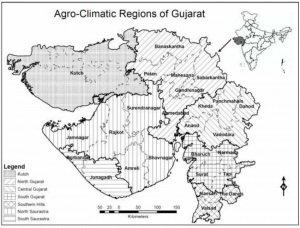Cropping Pattern of Gujarat

Agro and Sub Agro-Climatic Zones:
Gujarat lies in the Agro Climatic Zone-XIII, which is called as “Gujarat Plains and Hills region”/ Traditionally Gujarat was divided into three regions, viz. (i) the main land plains extending from the Rann of Kutch and the Aravalli hills in the North to Damanganga in the South, (ii) the hilly peninsular region of Saurashtra and the rocky areas of Kutch and (iii) the North-eastern hill tract. Now it is divided into 7 sub-agro climatic zones :
Southern Hills (Dangs, Valsad), Southern Gujarat, Middle Gujarat, North Gujarat, North-West Arid, North Saurashtra and South Saurashtra. Most of Gujarat falls under mega thermic category with mean soil temperature exceeding 28°C. Air temperature in January normally remains over 10°C. Maximum temperature in May goes over 40°C in North and North-west Gujarat. It is more moderate in the coastal area of Saurashtra and south Gujarat.
Rainfall is the most dominant climatic factor. Average rainfall is 828 mm, received in 35 days mostly from June to September with a coefficient of variation (CV) of 50%. Spatially it ranges from 300 mm in North-West to 2,000 mm in South-East. Twelve out of 26 districts of Gujarat are drought prone. In years of poor rainfall, the yields of important crops like groundnut which are mainly rainfed can reduce by 70% or more.
Cropping Pattern:
The main crops grown in Kharif season are Great Millet, Bajra, Maize, Paddy, Groundnut and in Rabi season these are Cotton, Wheat, Mustard, Cumin and Vegetables. Besides, Sugarcane is also grown in some districts. While the performance of rice, wheat, pulses and cotton in Gujarat is below the national average, the performance is above the national average for coarse cereals, oils seeds and onion. Although potato is not a major crop, its yields in Gujarat are high. The State finds a place among the top 3 in terms of productivity of bajra, groundnut, sesame, rapeseed and mustard, castor, onion, banana, chikoo, guava, cauliflower and tobacco.
The net cropped area has varied from 9.60 million hectare to 9.67 million hectare during the last 10 years. This is a little over 49% of the total area of Gujarat. Cropping intensity varies according to rainfall and it has been about 105% in the recent years. There were 35,32,000 agricultural holdings in 1990–91. This number increased to 37,81,000 in 1995–96 and the average size of operational holding reduced from 2.93 ha to 2.62 ha in the same period. About 55% of the holdings fell under marginal and small size group in 1995–96, against 78% at the national level. Average size of holding was 86% larger than the national average.
As in the rest of India, there has been a steady shift from animal power to electro-mechanical sources of power in Gujarat although the rate of change has been slower than that of the leading agricultural States. The availability of power is estimated at 1.20 kW/ha which is less than the average power availability in the country. About 90% of power comes from tractors, engines and motors.The sale of tractors is on the rise and during 2009-10, about 24, 291 tractors were sold in Gujarat by different tractor manufacturers in Gujarat. One of the manufacturer in Gujarat is making good quality rotavators and is selling more than 1000 rotavators per month. There are a good number of manufacturers making good quality farm implements. There is good scope for introducing improved equipment for performing various farm operations for cultivation of rice, wheat, pulses and cotton in Gujarat.
Changing cropping pattern in Gujarat has reported a significant shift from area sown in rabi only to double/triple cropping area, suggesting that due to availability of irrigation, it has been possible to take more than one crop. The highest increase in multi-cropping area has been registered in the Saurashtra region, followed by Northern and Central regions. During the past five years ending 2010–11, there has been a change in cropping pattern favouring commercial crops. The main driver for such transformation has been the technology, supported by infrastructure like good roads, improved market accessibility, ensured power supply to farmers, higher productivity of commercial crops, better market price and thereby favourable farm economies. The study has revealed that Saurashtra region dominates in cultivation of oilseeds, commercial, spices and vegetable crops in the state. The southern region is front-runner in the cultivation of fruits and flowers. The northern region dominates in cultivation of cereal crops, whereas the central region has the highest area under cultivation for pulses.
GPSC Notes brings Prelims and Mains programs for GPSC Prelims and GPSC Mains Exam preparation. Various Programs initiated by GPSC Notes are as follows:-- GPSC Mains 2025 Tests and Notes Program
- GPSC Prelims Exam 2025- Test Series and Notes Program
- GPSC Prelims and Mains 2025 Tests Series and Notes Program
- GPSC Detailed Complete Prelims Notes
